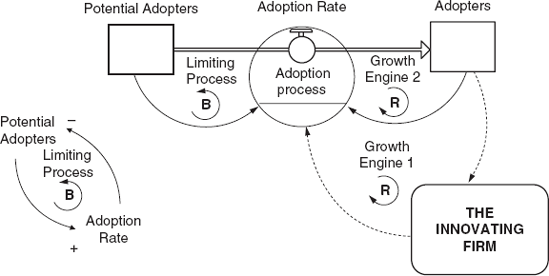6.1. Stocks and Flows in New Product Adoption– A Conceptual Diffusion Model
To transform this feedback view of diffusion into a simulation model we go straight to a stock and flow representation. The reason for this direct approach is that product adoption can be conceived very naturally in terms of a stock and flow network that moves consumers from one state (not owning the product) to another state (owning the product). However bear in mind that to achieve S-shaped growth two interacting feedback loops, a reinforcing growth engine and limiting effect, are also needed. Figure 6.2 shows a simple stock and flow network involving two stock accumulations linked by a single flow rate. Potential adopters on the left are converted to adopters on the right by the adoption rate.
Figure 6.2. Stock and flow network and possible feedback loops in the adoption of a new product

To discover plausible feedback loops we need to think about the adoption process and the factors that influence it. Suppose we start with a dynamic hunch that a growth engine lies in the interaction between the innovating firm and the market. This is a reasonable assumption and leads to a feedback process of the kind depicted on the lower right of Figure 6.2. The innovating firm informs the market of its new product and persuades customers to adopt, so creating a link (an information link in this case) from the firm ...
Get Strategic Modelling and Business Dynamics: A Feedback Systems Approach now with the O’Reilly learning platform.
O’Reilly members experience books, live events, courses curated by job role, and more from O’Reilly and nearly 200 top publishers.

